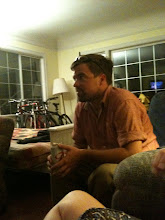For those unfamiliar with Septic Systems a brief primer.
A Septic System consists of three parts: a tank, a distribution box and a drain field. Effluent from the house (bath water, laundry soap, poopy, etc...) enters the septic tank. in the tank solids settle to the bottom and liquid rises to the top where there is an outlet. The outlet drains via gravity to the distribution box (or D-Box (different than a D-Bag) in the parlance of the trade). The distribution box splits the one input into multiple outputs that lead to the drain field. The drain field is an array of perforated pipes laid on gravel at the permeable layer (that part of the subsoil that water can easily travel through. The liquid effluent (having been separated from its solids) flows through the drain field and gradually seeps into the ground where it is continuously filtered by dirt and other particulates until it reaches ground water. The septic system doesn't so much keep you from dumping sewage into water as much as slows it down considerably.
The system being installed for the bakery differs from this model in two ways. A. it has a two compartment tank (most septic tanks do) this allows for "double separation" and keeps more "shit" (solids) out of the drain field. B. It has a pump. This is because the current D-Box is uphill from where the bakery is located. Typically these things are all gravity fed.
The work is being done by Raymond Harrison and Sons Septic Contractors. The excavator is being operated by a very talented guy named Andrew. It's nice to see someone so good at something you had never considered being good at before. So tuesday the tank was put in, yesterday they laid most of the line to the D-Box and today they finished the line and began work on the inlet side of the box. While they are here they are also excavating the slab and footers for the concrete foundation of the bakery building.
What fun! What a mess!
 The trench with pipe being laid in it. (the tank's top is visible in the foreground, Andrew is visible in the middle distance, in the trench)
The trench with pipe being laid in it. (the tank's top is visible in the foreground, Andrew is visible in the middle distance, in the trench)
Backhoe and Oven, together at last.





